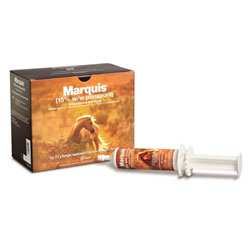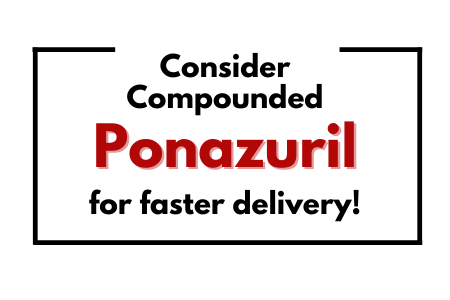Marquis (ponazuril) Paste
The First Approved Treatment of EPM in Horses
- Quick prep and delivery once your vet approves.
- Custom strengths available
- 15% w/w ponazuril
- Anti-protozoal oral paste
- The first approved treatment for equine protozoal myeloencephalitis (EPM)
- Administered once a day for 28 days
- One single tube: 127g Syringe + Reusable Plunger Free Shipping
*Manufacturer restricts additional discounts on this item unless explicitly specified
Description
The First Approved Treatment Of Equine Protozoal Myeloencephalitis (EPM) In Horses- For Oral Use Only
Ponazuril, the active ingredient in Marquis, crosses the blood/brain barrier to reach the central nervous system where it kills Sarcocystis neurona,1,2 and stops parasite from inflicting further damage to the central nervous system. Concentrations achieved in the CSF at steady state were shown to kill 94% of merozoites in cell culture.2
- Marquis is easy to administer and safe when used as directed.
Dosage
5 mg/kg (2.27 mg/lb) body weight once daily for a period of 28 days
Ingredients
The life cycle of EPM requires both a definitive host and an intermediate host.
- An intermediate host is one in which the parasite lives, but does not reproduce or shed an infective form of the parasite.
- In the case of EPM, the intermediate host ingests the sporocyst – the sporocyst hatches in the gut of the intermediate host and releases sporozoites.
- These sporozoites then invade the vasculature of the host and are carried to muscle tissue where they form muscle cysts, called Sarcocysts.
- Intermediate hosts for EPM include the nine banded armadillo, the striped skunk, raccoons and domestic cats. A study has shown that 59% of raccoons have tested positive to S. neurona. Oppossums become infected by eating the road-killed carcass of naturally infected raccoons.4
- The definitive host of EPM is the opossum. A definitive host is one in which the parasite reproduces in the intestine and releases an infective form of the organism (in the case of EPM, the infective form of the organism is the egg, called a sporocyst).1
Risk Factors Associated with EPM
- The competency of the immune system of the horse can certainly play a role in the disease – the immune system can be compromised during times of stress and the horse could begin to exhibit signs of the disease. Therefore younger horses with developing immune systems or older horses with compromised immune systems can be at risk.
- Also horses who are in heavy training or whose immune systems are stressed from being shipped long distances for competitive events can be at risk.
- Of course those horses who have a higher exposure to the sporocysts due to the presence of opossums are at risk.
- Horses residing on premises where EPM was previously diagnosed have an increased risk for developing EPM.
by Merial
Description
The First Approved Treatment Of Equine Protozoal Myeloencephalitis (EPM) In Horses- For Oral Use Only
Ponazuril, the active ingredient in Marquis, crosses the blood/brain barrier to reach the central nervous system where it kills Sarcocystis neurona,1,2 and stops parasite from inflicting further damage to the central nervous system. Concentrations achieved in the CSF at steady state were shown to kill 94% of merozoites in cell culture.2
- Marquis is easy to administer and safe when used as directed.
Dosage
5 mg/kg (2.27 mg/lb) body weight once daily for a period of 28 days
Ingredients
The life cycle of EPM requires both a definitive host and an intermediate host.
- An intermediate host is one in which the parasite lives, but does not reproduce or shed an infective form of the parasite.
- In the case of EPM, the intermediate host ingests the sporocyst – the sporocyst hatches in the gut of the intermediate host and releases sporozoites.
- These sporozoites then invade the vasculature of the host and are carried to muscle tissue where they form muscle cysts, called Sarcocysts.
- Intermediate hosts for EPM include the nine banded armadillo, the striped skunk, raccoons and domestic cats. A study has shown that 59% of raccoons have tested positive to S. neurona. Oppossums become infected by eating the road-killed carcass of naturally infected raccoons.4
- The definitive host of EPM is the opossum. A definitive host is one in which the parasite reproduces in the intestine and releases an infective form of the organism (in the case of EPM, the infective form of the organism is the egg, called a sporocyst).1
Risk Factors Associated with EPM
- The competency of the immune system of the horse can certainly play a role in the disease – the immune system can be compromised during times of stress and the horse could begin to exhibit signs of the disease. Therefore younger horses with developing immune systems or older horses with compromised immune systems can be at risk.
- Also horses who are in heavy training or whose immune systems are stressed from being shipped long distances for competitive events can be at risk.
- Of course those horses who have a higher exposure to the sporocysts due to the presence of opossums are at risk.
- Horses residing on premises where EPM was previously diagnosed have an increased risk for developing EPM.
by Merial








